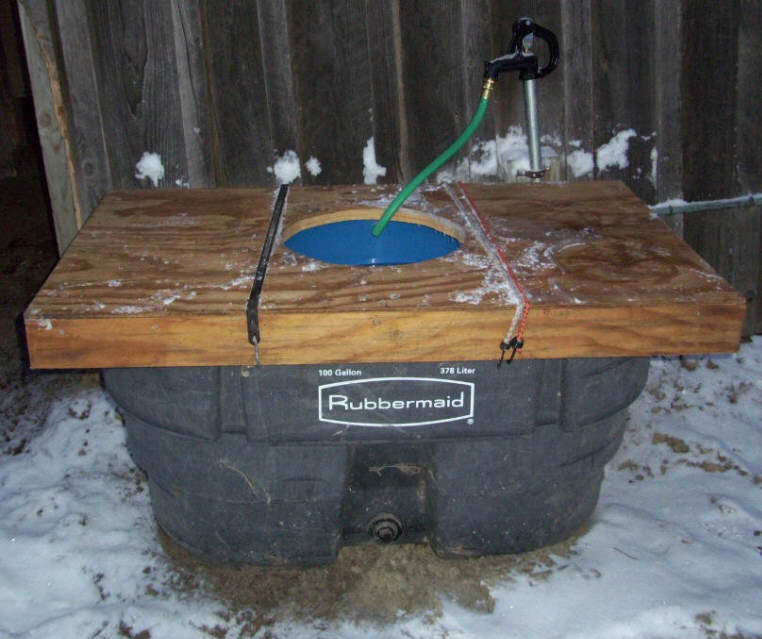
Search
The Renewable Energy site for Do-It-Yourselfers
A Super Insulated
Stock Tank
Making the Super Insulated Stock Tank
Thought I'd send you some pics of my horse stock tank improvements. We've had
the usual 100 gal plastic stock tank with a 1200 watt bottom tank heater for
many years making me dread the usual winter electric usage spike it caused. Due
to the water location, it's not a great place to try a solar stock tank. My wife
saw a 16 gallon heated watering bucket at TSC, the other day and wondered
whether we could somehow mount it in the existing tank. We're down to just 2
horses, these days, and didn't really need the larger tank.
This picture shows the 100 gal stock tank and the 16 gal heated bucket to be
installed and insulated in the larger tank. I taped the cord up to the side of
the 16 gal bucket and sprayed the outside of it with cooking spray, so hopefully
it could be removed after the Great Stuff set up. The idea was to have an
insulated bucket that could be removed for cleaning.

The 100 gallon outer tank, and the heated 16 gallon inner water tank.
I cut 3x 8" long spacers from some scrap 4" PVC I had, and foamed them in place
to the bottom of the tank with Great Stuff big crack filler. This spaced the 16
gal bucket slightly higher than the lip of the 100 gal stock tank.

The PVC pipe spacers that support the small inner tank.
I originally planned on filling all the open space with Great Stuff, and
quickly learned that was a stupid idea, so I looked around for other fillers. I
broke up a scrap of blue board that was headed to the land fill, added some
Styrofoam packing material, then added an old broken Styrofoam cooler. This
thing was eating up all my junk! The 1 to 2" space around and under the bucked,
I filled with Great Stuff. I ran out of filler material and ran to town to get
more, I was planning on packing peanuts, but all that was available in our town
were the biodegradable ones. I finally settled on a $7 package of EPS insulation
boards, and broke that up to finish the fill.

Filling the space between the two buckets with scrap Styrofoam
and Great Stuff insulation foam in a can.
The last inch or two on the entire top was filled with Great Stuff to bind it
all together. I originally planned on leaving this as the finished surface and
painting it, but it looked too much like horse candy, so I made a top out of
scrap plywood and 2x2's and insulated it with a scrap of Dow Tuff-r. The cover
can be seen leaning up in the background. I cut a 16" hole in the cover for the
horses, which is slightly smaller than the 20" opening in the bucket.

The last couple inches is filled with all Great Stuff foam.
The final product, cover on, and in use.

Cost and Performance
My cost was mainly in the Great Stuff. I used 12 cans costing a total of $60.
I also had $7 in EPS, that I could have avoided if I planned better and
collected some more packing Styrofoam at work. The heated bucket was $65, but it
could be argued that my 18 year old tank heater was on it's last legs anyway.
Everything else was scrap.
The only thing I would have done differently would have been to build up the
Great Stuff around the bucket over a couple of days instead of all in one day.
When we pulled the bucket out after I thought everything was cured, I found a
slimy mess around the outside of the bucket Luckily, it didn't just all slide
down to the bottom of the bucket depression. It pretty much stayed in place and
I was able to let it cure with the bucket removed.
The energy use has been much improved. I recently put my Kill-a-Watt meter on it
and measured 2.44 kWh over a 24 hr period. We had a high of 18 degrees and a low
of 12 degrees that day. This compares to the 6.27 kWh my previous heater used
when I measured it last year. That measurement was taken on a warmer day, with a
low in the teens and a high in the 20's. The new heater is rated at 260 watts
and measured 220 watts compared to the 1170 watts that the old heater drew. So,
the new setup is using 61% less electricity than the old setup (probably better
than this when you consider that the old heater was measured on a warmer day). I
imagine I'll be able to turn it off entirely when temps are in the 20's.
Scott Smith
Update from Scott:
Today, the weather warmed up a bit (15 degree low and 23 degree high).
This is pretty comparable to the temp when I measured the previous
heater last year. The usage over the last 24 hrs today was 1.62 kWh.
So it looks like it's using less than a third of the energy of the old
stock tank/1200 watt heater combo.
The only thing that maybe people should be aware of is all the filler I
used is not exactly fire retardant. Should never be an issue, but
should probably be mentioned.
Gary December 18, 2010






